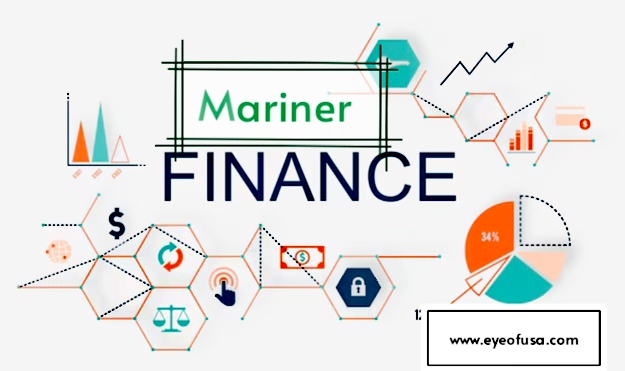At eyeofusa.com, we strive to provide our readers with detailed and reliable information on the most trusted financial services available in the United States. One such company is Mariner Finance, a well-established lender known for offering a range of personal loans and other financial products designed to meet the diverse needs of its customers. Whether you are looking to consolidate debt, finance a major purchase, or secure a home loan, Mariner Finance offers solutions that could be the right fit for you.
What is Mariner Finance?
Mariner Finance is a consumer finance company that provides personal loans, auto loans, home loans, and debt consolidation services. Founded in 2002, the company has grown rapidly and now operates over 450 branch locations across 22 states in the U.S. With a commitment to helping customers achieve their financial goals, Mariner Finance is dedicated to offering tailored loan products that meet the specific needs of individuals and families.
Mission and Values
Mariner Finance is built on the principles of integrity, customer focus, and community involvement. The company’s mission is to provide accessible and flexible financial solutions to individuals who may not have access to traditional lending options. By focusing on personal relationships and customer service, Mariner Finance aims to empower its clients to take control of their financial future.
Financial Services Offered by Mariner Finance
Mariner Finance offers a wide array of financial products designed to address various financial needs. Here’s a closer look at the key services they provide:
Personal Loans
Mariner Finance specializes in personal loans that can be used for a variety of purposes, such as home improvements, medical expenses, or unexpected bills. The company offers both secured and unsecured personal loans, with loan amounts typically ranging from $1,000 to $25,000, depending on the borrower’s creditworthiness and financial situation. Interest rates are competitive, and loan terms are flexible, typically ranging from 12 to 60 months.
Auto Loans
If you are in the market for a new or used vehicle, Mariner Finance offers auto loans with competitive interest rates. The company provides financing for both dealer-purchased and private-party vehicles, and they also offer refinancing options for existing auto loans. With a streamlined application process, you can secure financing quickly and get behind the wheel of your new car without unnecessary delays.
Home Loans
Mariner Finance offers home loans to help you achieve your dream of homeownership. Whether you are purchasing a new home or looking to tap into your home’s equity, Mariner Finance provides a variety of mortgage products, including home purchase loans and Home Equity Loans and Lines of Credit (HELOCs). These loans come with competitive interest rates and flexible terms, allowing you to choose the best option for your financial situation.
Debt Consolidation
One of the standout services offered by Mariner Finance is debt consolidation. If you are struggling with high-interest debt from multiple sources, a debt consolidation loan can help you simplify your payments and potentially reduce your interest rate. Mariner Finance offers customized consolidation plans that allow you to combine multiple debts into a single, manageable monthly payment. This can help you save money on interest and get out of debt faster.
Application Process
Applying for a loan with Mariner Finance is straightforward, and the company provides both online and in-person options.
Eligibility Requirements
To qualify for a loan with Mariner Finance, you typically need to meet certain eligibility requirements. These may include a minimum credit score, proof of steady income, and employment verification. While Mariner Finance is known for working with borrowers who may not have perfect credit, your credit score will still play a role in determining your loan terms and interest rate.
How to Apply
Applying for a loan is simple and can be done in a few steps:
- Online Application: Visit the Mariner Finance website and fill out the online application form. You’ll need to provide basic information about yourself, your income, and your financial needs.
- In-Person Application: If you prefer to apply in person, you can visit one of Mariner Finance’s branch locations to complete your application with the help of a loan officer.
- Approval Process: Once your application is submitted, Mariner Finance will review your information and make a decision. In many cases, you can receive a decision within the same day.
- Loan Disbursement: If approved, your loan funds will be disbursed quickly, often within one to two business days.
Mariner Finance Customer Experience
Customer experience is a critical factor when choosing a lender, and Mariner Finance strives to provide excellent service at every step of the way.
Customer Service
Mariner Finance offers robust customer service options, including phone support, online chat, and in-person assistance at their branch locations. Their customer service team is available to answer questions, provide guidance, and help you navigate the loan process. Whether you need help with an application or have questions about your loan terms, Mariner Finance’s customer support team is there to assist you.
Customer Reviews and Testimonials
Customer reviews and testimonials often highlight the positive experiences borrowers have had with Mariner Finance. Many customers appreciate the personalized service and the ability to work with loan officers who understand their unique financial situations. While there are always some negative reviews, particularly related to high-interest rates for certain borrowers, overall, the company maintains a solid reputation for customer satisfaction.
Pros and Cons
Pros:
- Flexible loan options tailored to individual needs.
- Fast application and approval process.
- Availability of both secured and unsecured loans.
- Extensive branch network across the U.S.
Cons:
- Interest rates can be high for borrowers with lower credit scores.
- Limited availability in some states.
Mariner Finance Locations
With over 450 branches across 22 states, Mariner Finance is accessible to many Americans.
Branch Locations Across the US
Mariner Finance operates in major states such as Texas, California, Florida, and New York, as well as in many smaller communities. This wide network ensures that customers can find a local branch to meet with a loan officer and discuss their financial needs in person.
How to Find a Local Branch
Finding a local Mariner Finance branch is easy using their online branch locator tool. Simply enter your ZIP code or city, and the tool will display the nearest branches, along with contact information and hours of operation.
Comparison with Competitors
When choosing a lender, it’s important to consider how Mariner Finance stacks up against its competitors.
Mariner Finance vs. Other Lenders
Compared to other lenders, Mariner Finance is known for its personalized approach and willingness to work with borrowers who may have less-than-perfect credit. While some competitors may offer lower interest rates or more extensive online services, Mariner Finance excels in customer service and providing flexible loan options.
Why Choose Mariner Finance?
The primary reasons to choose Mariner Finance include their focus on customer service, the availability of a wide range of loan products, and their commitment to working with borrowers who may not qualify for traditional loans. If you value personalized service and the ability to meet with a loan officer in person, Mariner Finance may be the right choice for you.
Financial Education and Resources
In addition to loan products, Mariner Finance offers a variety of financial education resources to help customers make informed decisions.
Blog and Learning Center
Mariner Finance’s blog and learning center features articles on a wide range of topics, including budgeting, credit management, and loan tips. These resources are designed to help customers improve their financial literacy and make better financial decisions.
Tools and Calculators
The company also provides tools and calculators to help you plan your finances. For example, their loan calculator can help you estimate your monthly payments and determine how much you can afford to borrow.
Conclusion
Mariner Finance offers a comprehensive range of financial products designed to meet the needs of everyday Americans. With flexible loan options, a customer-focused approach, and a strong presence across the United States, Mariner Finance is a valuable option for those seeking financial assistance. Whether you’re looking to consolidate debt, finance a major purchase, or buy a home, Mariner Finance has the resources and expertise to help you achieve your financial goals.
Frequently Asked Questions (FAQ)
Q: What types of loans does Mariner Finance offer?
A: Mariner Finance offers personal loans, auto loans, home loans, and debt consolidation services.
Q: How can I apply for a loan with Mariner Finance?
A: You can apply online through their website or in person at one of their branch locations.
Q: Does Mariner Finance work with borrowers who have bad credit?
A: Yes, Mariner Finance is known for working with borrowers who may have lower credit scores.
Q: How long does it take to get approved for a loan?
A: Many applicants receive a decision on the same day they apply, and funds are typically disbursed within one to two business days.
For more information on financial services and tips, visit us at eyeofusa.com.









